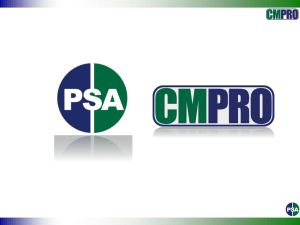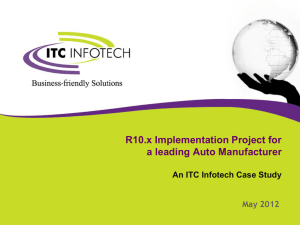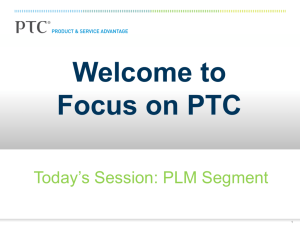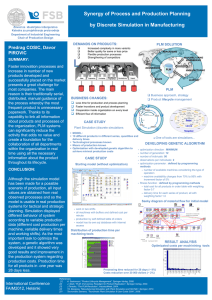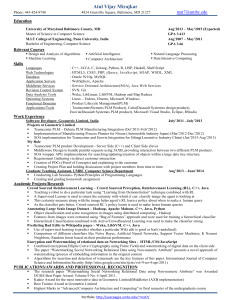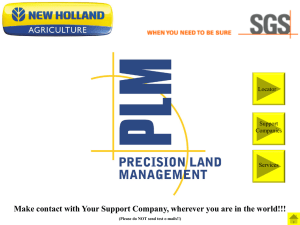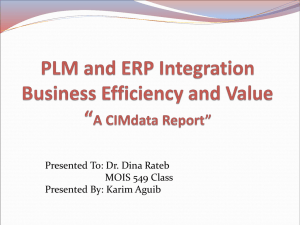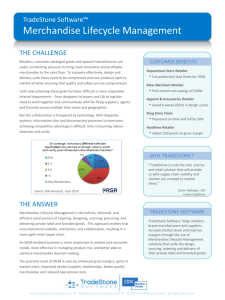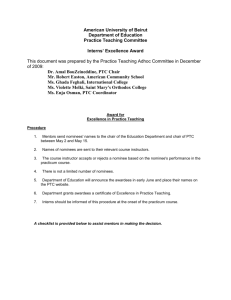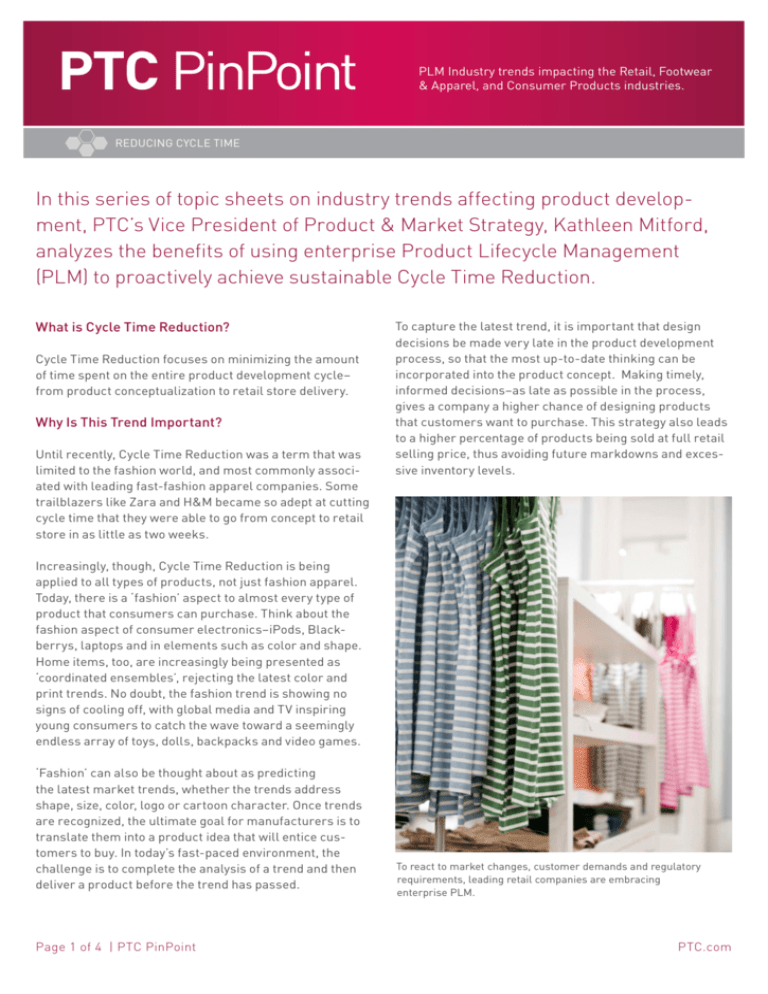
PLM Industry trends impacting the Retail, Footwear
& Apparel, and Consumer Products industries.
Reducing Cycle Time
In this series of topic sheets on industry trends affecting product development, PTC’s Vice President of Product & Market Strategy, Kathleen Mitford,
analyzes the benefits of using enterprise Product Lifecycle Management
(PLM) to proactively achieve sustainable Cycle Time Reduction.
What is Cycle Time Reduction?
Cycle Time Reduction focuses on minimizing the amount
of time spent on the entire product development cycle–
from product conceptualization to retail store delivery.
Why Is This Trend Important?
Until recently, Cycle Time Reduction was a term that was
limited to the fashion world, and most commonly associated with leading fast-fashion apparel companies. Some
trailblazers like Zara and H&M became so adept at cutting
cycle time that they were able to go from concept to retail
store in as little as two weeks.
To capture the latest trend, it is important that design
decisions be made very late in the product development
process, so that the most up-to-date thinking can be
incorporated into the product concept. Making timely,
informed decisions–as late as possible in the process,
gives a company a higher chance of designing products
that customers want to purchase. This strategy also leads
to a higher percentage of products being sold at full retail
selling price, thus avoiding future markdowns and excessive inventory levels.
Increasingly, though, Cycle Time Reduction is being
applied to all types of products, not just fashion apparel.
Today, there is a ‘fashion’ aspect to almost every type of
product that consumers can purchase. Think about the
fashion aspect of consumer electronics–iPods, Blackberrys, laptops and in elements such as color and shape.
Home items, too, are increasingly being presented as
‘coordinated ensembles’, rejecting the latest color and
print trends. No doubt, the fashion trend is showing no
signs of cooling off, with global media and TV inspiring
young consumers to catch the wave toward a seemingly
endless array of toys, dolls, backpacks and video games.
‘Fashion’ can also be thought about as predicting
the latest market trends, whether the trends address
shape, size, color, logo or cartoon character. Once trends
are recognized, the ultimate goal for manufacturers is to
translate them into a product idea that will entice customers to buy. In today’s fast-paced environment, the
challenge is to complete the analysis of a trend and then
deliver a product before the trend has passed.
Page 1 of 4 | PTC PinPoint
To react to market changes, customer demands and regulatory
requirements, leading retail companies are embracing
enterprise PLM.
PTC.com
“Reducing cycle time has clear financial benefits for retailers and wholesalers.
Our research shows that for every four weeks taken out of a cycle, margins
increase by one (1) point at retail.”
– Jeremy Rubman, KSA
Another factor that’s forcing manufacturers to deliver
the right products to the store at the right time is that,
because of today’s volatile economic environment,
consumers have less discretionary income to spend. To
avoid excess inventory, management must make design
decisions later in the process, which gives a company the
opportunity to analyze the recent sales data, so quantities
of products can be accurately forecasted.
What business processes are impacted most by
cycle time reduction – and how can Plm enable
these processes?
To make a significant impact on your overall cycle time,
managers must take a close look at every process
in the product development system. Companies that
have significantly reduced their cycle time realize that
all departments – from up-front planning to back-end
delivery – must work together in a choreographed way.
Here are the areas impacted most by
Cycle Time Reduction:
Merchandising and Design Process
Merchandising kicks off the product development process by
providing clear direction of the plan for the seasons to come,
including the financial goals, with information such as:
•Target retail, target cost, and margins
• Assortment goals for the type of product mix
• Creative goals based on the current season trends
These merchandise plans, created either in a Merchandise
Planning System or directly in a PLM system, are translated into line plans with placeholders that include directional product information for the design team.
In a PLM system, designers can design multiple product candidates for each placeholder and easily share the
product concepts with the merchandising team. The tight
collaboration between Merchandising and Design, early in
the product development process, allows the design team
to focus their design efforts on the type of products that
merchandising will be adopting into the line, thus ensuring
valuable time and effort are not wasted either on products
that will never make it to line adoption, or on late adds.
Page 2 of 4 | PTC PinPoint
Constantly changing consumer trends require retailers and brands
to stay in touch with consumers’ needs and interests.
Creative Design: Integration of Adobe® Illustrator®
into the Design Process
As the design process continues, PLM provides multiple
ease-of-use features to accelerate the translation of a
designer’s idea into a product concept that can be shared
with the rest of the team.
Advanced PLM solutions, such as PTC® Windchill®
FlexPLM™, offer a direct integration with Adobe Illustrator (AI), which allows a designer to quickly create a product specification from within AI. From within the familiar
Adobe user interface, the designer can access color and
material libraries from FlexPLM and assign these to a
product–along with descriptive product attributes – to
generate a product ‘design card’. The fast generation of
the product spec is important early in the design process,
so a product can either be accelerated or failed quickly.
PTC.com
Customer PinPoint:
Cycle Time Reduction at JCPenney
To keep up with consumer demand and fast fashion trends in the Retail and
Apparel industries , JCPenney realized that it had to decrease the amount
of time it takes to develop a new product line from several months down
to a few weeks. To accomplish this objective, JCPenney launched its cycle
Time Reduction initiative, an enterprise-wide program focused on shortening the amount of time from conceptualization to merchandise delivery.
“The ability to respond to customer needs quickly, and deliver merchandise
efficiently, is critical to delivering on JCPenney’s vision to be the preferred
shopping choice for middle America.
As an important enabler to our Cycle Time Reduction initiative, FlexPLM
is a robust infrastructure that spans our global supply chain, enabling our
Associates to collaborate more effectively and deliver merchandise that
inspires our customers.”
– Peter McGrath
EVP Production Development and Sourcing for JCPenney
Calendar Management
Early Sourcing
One of the most important–and most challenging–disciplines for achieving Cycle Time Reduction is adhering to
a calendar. The difficulty here is that each product has its
own cycle time, but all products must be delivered to the
retail store at the same time.
PLM solves this issue because it allows you to manage
seasonal calendars, yet maintain different calendars
with different milestones by product type. For example,
a ‘fashion’ item may have a six-week calendar, but a core
or basic item may follow a traditional 32-week calendar.
Easily managing multiple calendars is a key requirement
for reducing non-value added activities during the product
development process.
As all job functions in the product development process
are accessing a common, web-based PLM system, the
Sourcing team has visibility into the line from conceptualization. This insight allows Sourcing to begin thinking about those manufacturers best suited to producing
the product. A search of suppliers against the product
requirements can be executed quickly, so potential suppliers can be identified to place a request for quote. PLM
is capable of housing vital supplier information, such as
the supplier’s current capacity and past performance, in a
vendor scorecard, so that decisions can be made quickly.
As quotes are received from the supply chain, PLM provides an efficient way to analyze multiple quotes, so that
Sourcing can make informed placement decisions fast.
Specification Development Process
Supply Chain Collaboration
The Specification Development Process can be accelerated
using a PLM solution because data from the design concept has already pre-populated the product specification.
PLM allows you to define product templates for different
product types, so you can then quickly create the product
specification. In addition, PLM offers multiple ease-ofuse features such as defining copy rules by product type,
linking specifications of similar products, and clipboard
copying, which enable the quick generation of the spec.
This ease-of-use feature is key to delivering the spec to the
manufacturer faster, as well as reducing time spent resolving quality issues once the product has been produced.
Once a product has been placed with a supplier, PLM
enables supply chain collaboration by giving the supplier
direct access to the related product information residing
in the PLM system. With proper authorization managed by
the PLM system, the supplier has access to view information, as well as to make updates to parts of the product
specification or calendar that they own. This direct integration to the supply chain saves valuable time otherwise
spent communicating through email or updating data in
multiple systems.
Page 3 of 4 | PTC PinPoint
PTC.com
“
Product development used with product lifecycle management (PLM)
tools and best practices is often justified by hard cost savings alone via
material savings, reduced administrative labor, and the elimination of
redundant system maintenance. When complemented with dramatic
increases in speed to market, it provides a compelling and strategically
important value proposition. The benefits are real: initial implementations
have generated 20% lead-time reductions via improved visibility and
accountability. With advanced postponement techniques, lead times have
been reduced by as much as 50%.”
– AMR Research
What are the Benefits of addressing Cycle time
Reduction in Plm?
By leveraging web-based, collaborative PLM tools,
companies have greater visibility into the right data, which
allows them to make smarter decisions faster–as late
as possible in the development cycle–without impacting
costs and schedules.
A more difficult benefit to measure in PLM is the increased
efficiency of the product development team. PTC’s experience shows that by having all internal and external team
members working from a ‘single source of the truth,’ team
members are not wasting precious time chasing down
data or working on inaccurate information. As a result,
designers, in particular, benefit from being able to focus
on innovation.
Lastly, PLM can directly benefit sell-through and inventory
management, as companies can make smarter design
decisions later in the process regarding what types of
products should be offered for a particular retail delivery. With PLM, companies in Retail, Footwear & Apparel,
and Consumer Products can achieve the ultimate goals
of Cycle Time Reduction: cutting overall man hours and
eliminating wasted inventory.
To learn more about how PTC can address your PLM and
Cycle Time Reduction, please visit:
PTC.com/industry/retail
Page 4 of 4 | PTC PinPoint
Early visibility throughout the supply chain process can decrease
costs, inventory errors, and compliance issues.
© 2013, PTC Inc. (PTC). All rights reserved. Information described herein is furnished
for informational use only, is subject to change without notice, and should not be taken
as a guarantee, commitment, condition or offer by PTC. PTC, the PTC logo, Windchill,
and all other PTC product names and logos are trademarks or registered trademarks
of PTC and/or its subsidiaries in the United States and other countries. All other
product or company names are property of their respective owners. The timing of
any product release, including any features or functionality, is subject to change at
PTC’s discretion.
PTC.com

